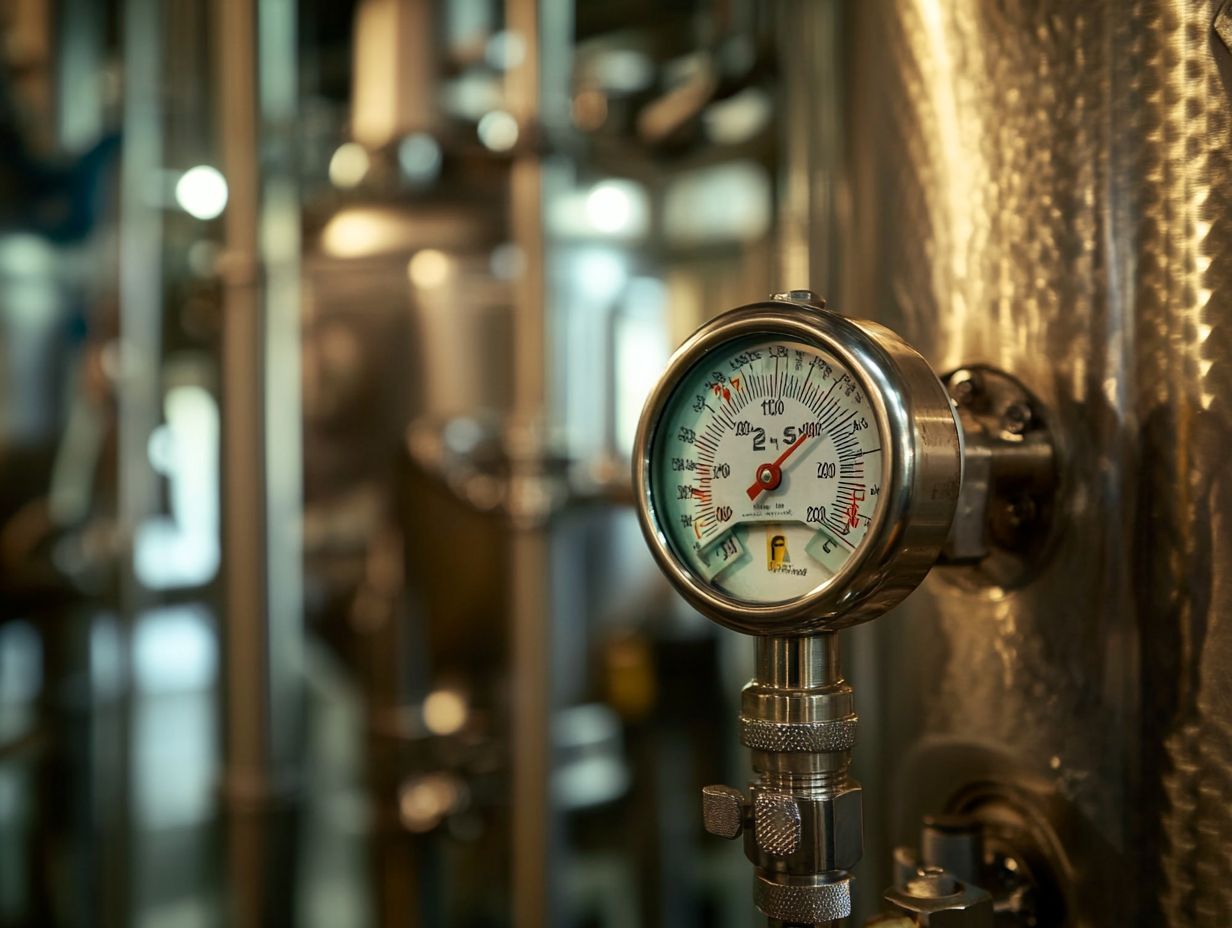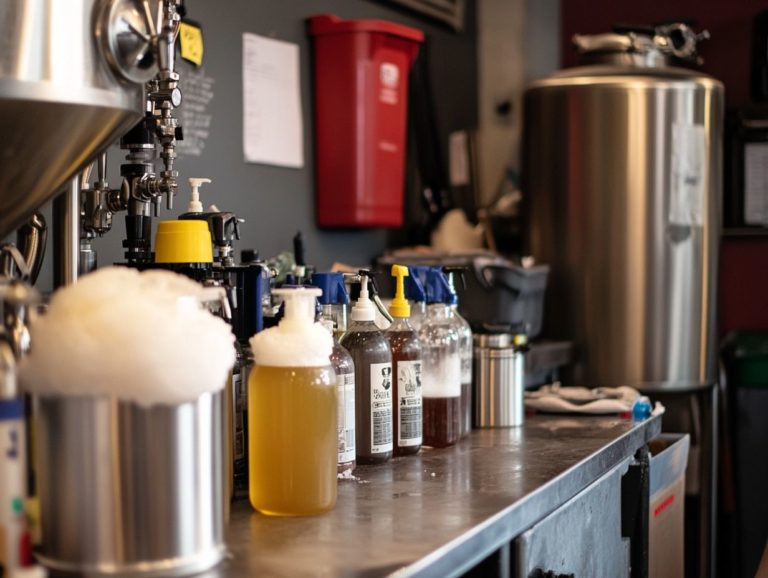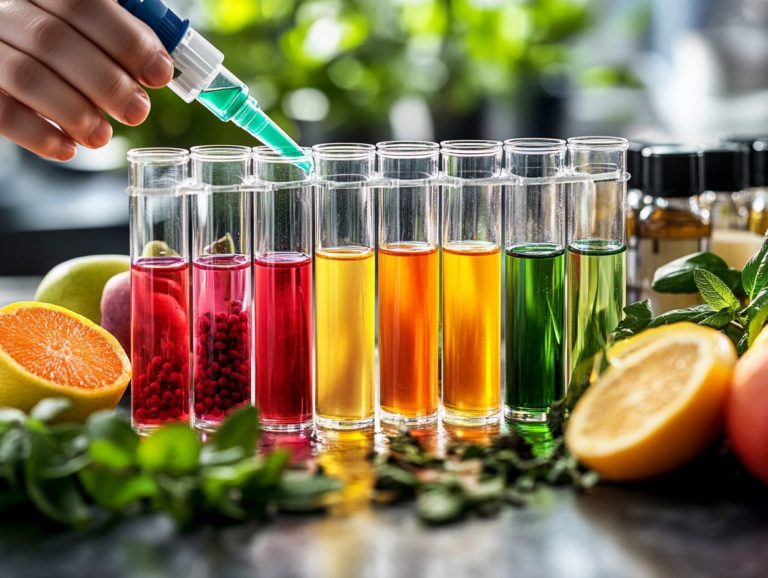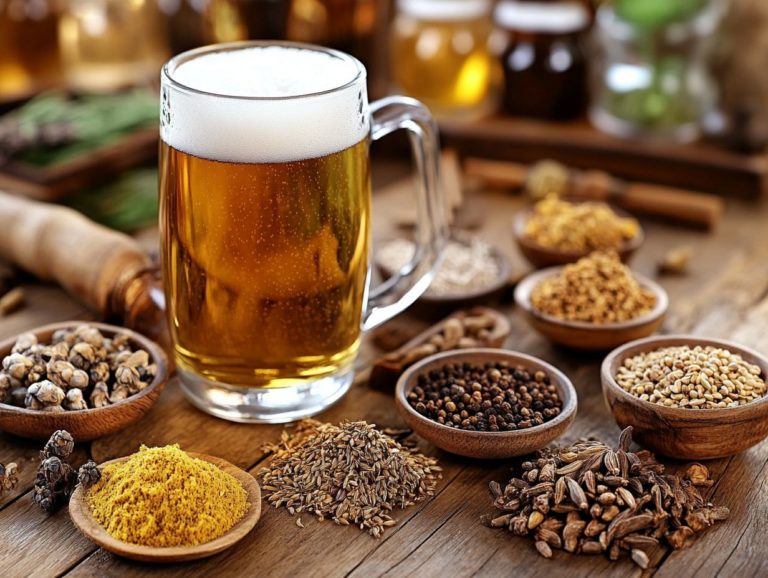Identifying and Fixing Fermentation Temperature Issues
Fermentation is the process where microorganisms, primarily yeast, transform sugars into alcohol and carbon dioxide. Understanding fermentation temperature is essential for successful brewing, baking, or yogurt-making. This article delves into the ideal fermentation temperature ranges for various fermentation types, identifies the signs of temperature-related issues, and offers effective strategies to tackle both high and low temperature challenges.
You ll uncover common mistakes that can derail your efforts and discover tools and practices to monitor and maintain the perfect fermentation environment, optimizing your fermentation process. Get ready to take your fermentation skills to the next level!
Contents
- Key Takeaways:
- What Is Fermentation Temperature and Why Is It Important?
- What Are the Ideal Temperatures for Fermentation?
- What Are the Optimal Temperatures for Different Types of Fermentation?
- What Are the Signs of Temperature Issues During Fermentation?
- How Does High Temperature Affect Fermentation?
- How to Fix High Temperature Issues During Fermentation?
- How to Prevent High Temperature Issues During Fermentation?
- How to Fix Low Temperature Issues During Fermentation?
- What Are Some Heating Methods for Fermentation?
- What Are the Common Mistakes in Controlling Fermentation Temperature?
- How to Monitor and Maintain the Right Fermentation Temperature?
- Frequently Asked Questions
- What are some common signs of fermentation temperature issues?
- How can I accurately measure the temperature of my fermentation process?
- What are some potential causes of temperature fluctuations during fermentation?
- How can I fix temperature issues during fermentation?
- Can I still salvage my beer if it has been affected by temperature issues during fermentation?
- Are there any steps I can take to prevent fermentation temperature issues in the future?
Key Takeaways:
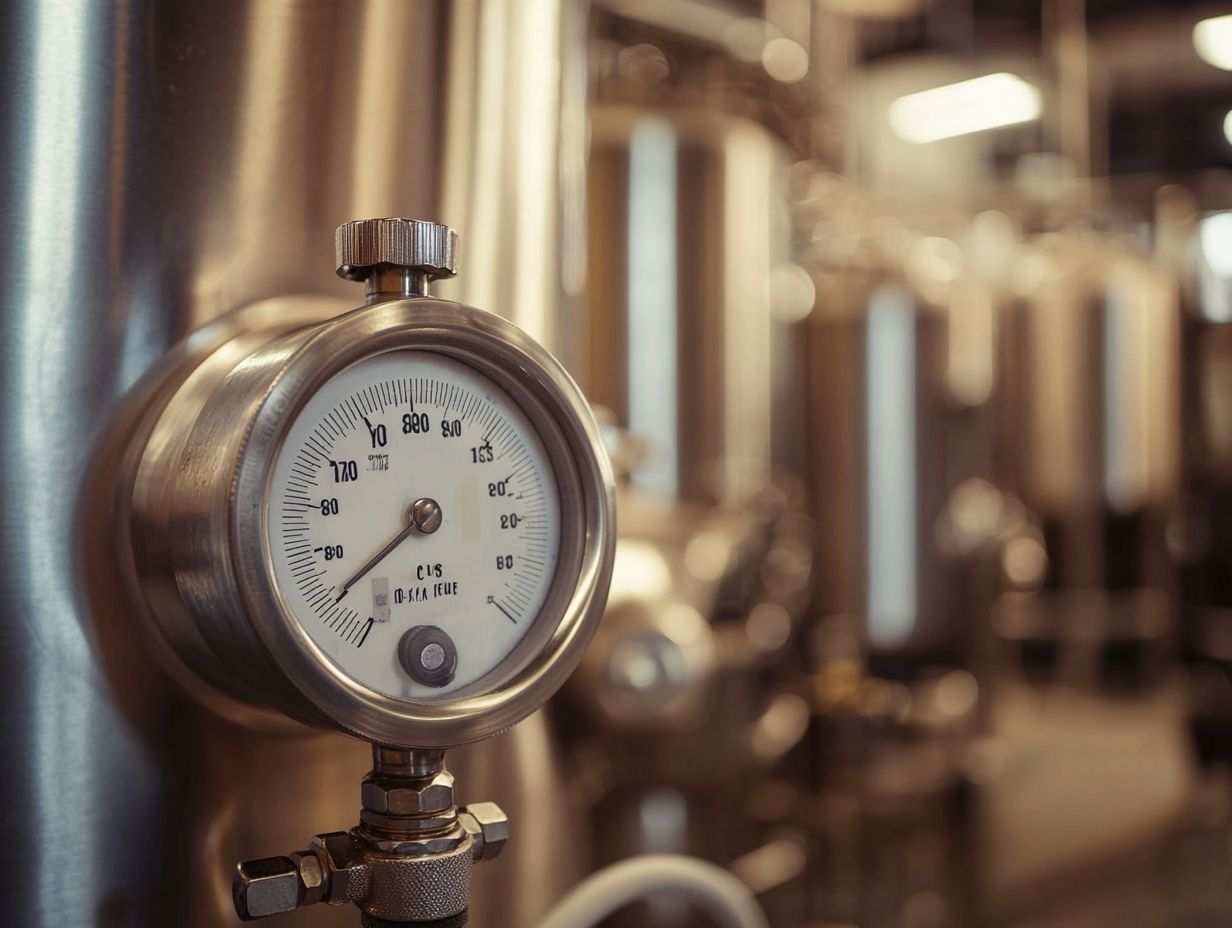
- Maintaining the correct temperature during fermentation is crucial for producing high-quality fermented products, ensuring optimum fermentation and consistent alcohol production.
- Different types of fermentation have varying ideal temperatures, making it important to understand and follow these guidelines.
- High or low temperatures can negatively affect fermentation and can be prevented or fixed through proper monitoring and the use of cooling or heating methods.
What Is Fermentation Temperature and Why Is It Important?
Fermentation temperature is very important in brewing because it affects how yeast works and how well fermentation goes, which shapes the final beer styles and flavors you produce.
This intricate biochemical dance involves yeast transforming sugars into alcohol and carbon dioxide. Maintaining the optimal fermentation temperature is essential for achieving consistent, high-quality results.
Mastering temperature control helps manage fermentation dynamics and behavior. Any fluctuations can lead to complications and the emergence of unwanted byproducts.
By grasping the importance of fermentation temperature and management, you can adopt effective practices that enhance brewing efficiency and elevate flavor complexity.
What Are the Ideal Temperatures for Fermentation?
The ideal fermentation temperatures are not one-size-fits-all; they vary based on the yeast strain you choose and the specific style of beer you aim to produce. This temperature range is key to achieving great fermentation results and boosting flavors.
For example, ale yeasts such as Saccharomyces cerevisiae typically favor warmer fermentation environments, whereas lager yeasts flourish in cooler settings. By grasping these nuances, you can refine your fermentation practices and uphold yeast health, paving the way for a successful brewing journey that yields well-balanced fermentation profiles.
What Are the Optimal Temperatures for Different Types of Fermentation?
Optimal fermentation temperatures vary across different types of fermentation, such as cold and warm fermentation. These temperatures are significantly influenced by the specific yeast strains you choose for your brewing process.
For instance, Kveik yeast is famous for its ability to ferment at higher temperatures. In contrast, traditional lager fermentation usually occurs at cooler ranges, resulting in distinct characteristics. Understanding these temperature ranges is important for you as a brewer, enabling the selection of the right brewing methods and ensuring the vitality of your yeast throughout the fermentation journey.
When you work with ale yeast, fermentation typically takes place between 60 F and 75 F. This temperature range allows for the development of fruity esters and phenols, which add complexity to your beer.
On the other hand, lager yeast thrives in cooler temperatures, generally around 45 F to 55 F. This promotes a clean and crisp profile with minimal esters. For example, if you brew a Belgian ale at the higher end of the ale spectrum, you might uncover rich flavors. Conversely, a pilsner fermented at the lower end will highlight a smooth finish.
The careful manipulation of these fermentation temperature ranges affects not only the fermentation rate but also plays a significant role in the final quality of your beer. This underscores the importance of precision in temperature control as you craft your brews.
What Are the Signs of Temperature Issues During Fermentation?
Identifying the signs of temperature issues during fermentation is crucial for effectively managing any fermentation problems and guaranteeing a successful brewing process.
Common indicators of temperature-related issues include unusual fermentation rates, off-flavors in your beer, and abnormal yeast activity. All of these suggest that the fermentation temperature might be straying from the ideal range.
By closely monitoring fermentation, you can detect these issues early on and make necessary adjustments to maintain yeast health and performance. This proactive approach ensures that the final product possesses the desired characteristics and flavors you aim for.
How Does High Temperature Affect Fermentation?
High temperatures during fermentation can create a host of problems, including accelerated yeast activity and the production of unwanted fermentation byproducts. These issues can significantly affect your brewing efficiency and the overall quality of your beer.
When yeast strains are stressed by excessive heat, you may encounter off-flavors such as fusel alcohols (a type of undesirable alcohol formed during fermentation) and esters (aromatic compounds that can add fruity flavors) that stray far from your intended fermentation profiles.
The dynamics of fermentation can change under high temperatures, leading to unpredictable fermentation rates and undesirable characteristics that detract from your final product. If your fermentation temperatures are too high, you risk ruining your batch! Act quickly to ensure the best flavors in your beer.
When yeast operates outside its optimal temperature range, you risk producing higher concentrations of those unwanted byproducts. This can create an imbalance in flavor compounds, leaving your beer tasting harsh or overly fruity.
If temperatures exceed 75 F (24 C), you might find yourself with phenolic compounds that contribute a medicinal or plastic-like aroma, disrupting your brewing techniques. Yeast can become sluggish or even stall, complicating the fermentation process as you strive to achieve your desired alcohol content and flavor profile.
Temperature problems can ruin not only the taste but also how your beer feels in your mouth. Don’t let that happen! These temperature-induced fermentation issues can compromise not just the taste but also the overall mouthfeel and stability of your beer, creating significant challenges as you work toward product consistency.
How Does Low Temperature Affect Fermentation?
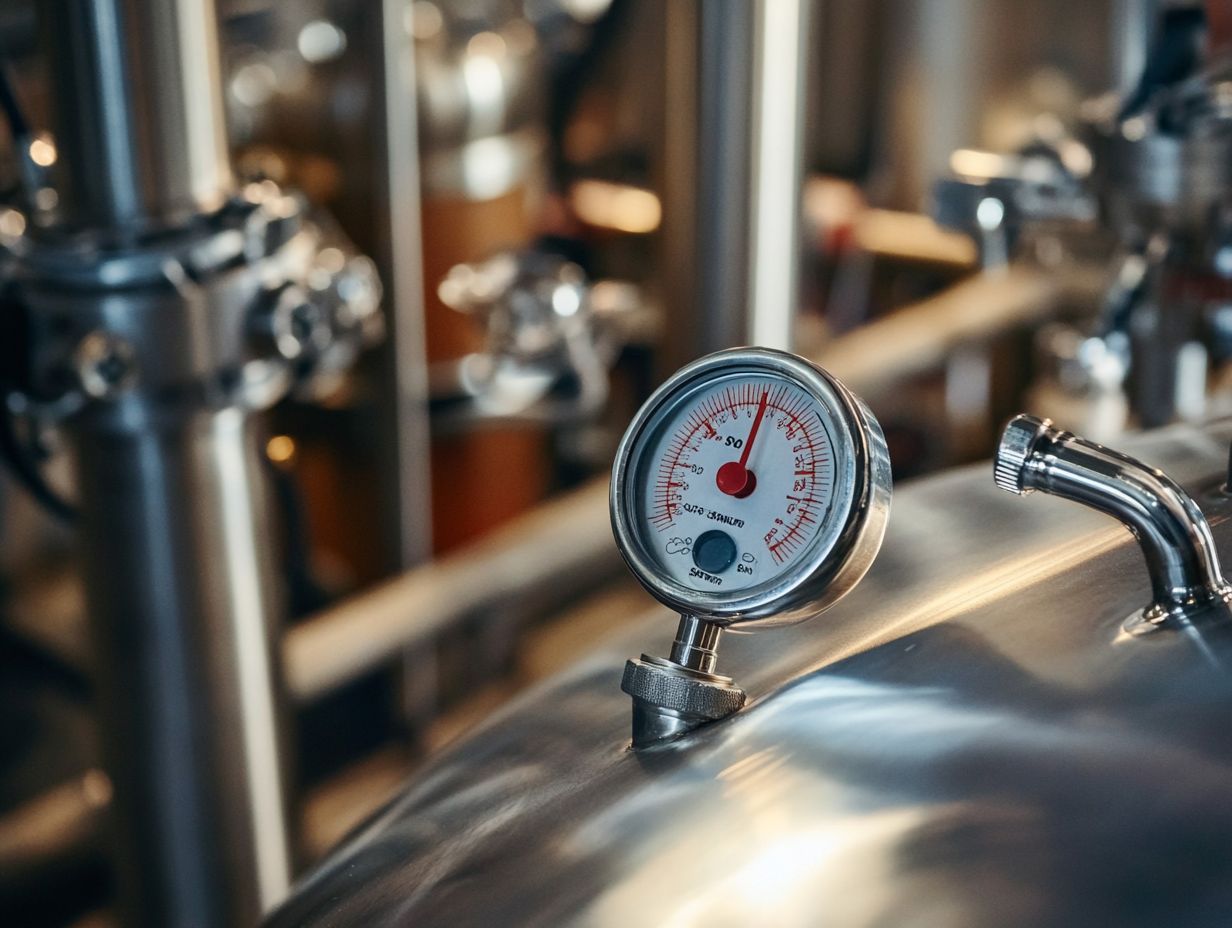
Low temperatures during fermentation can present quite the dilemma for you. They lead to sluggish fermentation rates and diminished yeast vitality, both of which can detrimentally affect your brewing conditions and the final quality of your beer.
When fermentation takes place at temperatures lower than ideal, yeast activity slows down considerably. This can result in incomplete fermentation and unwanted off-flavors that tarnish your beer s profile, impacting fermentation science. Grasping the implications of low fermentation temperatures is essential for you as a brewer. It enables you to implement effective yeast management strategies throughout the brewing process.
For example, when brewing lagers, if the fermentation temperature is too low, the yeast may produce fewer esters and phenols. This can lead to a lack of flavor complexity. Low temperatures can also cause increased sedimentation, potentially leaving unfermented sugars behind, which could create a cloying sweetness without the balance you re aiming for.
To combat these challenges, consider raising the temperature toward the end of fermentation. This technique, known as a diacetyl rest, is an essential part of yeast management. It encourages the yeast to clean up any undesirable byproducts.
Selecting yeast strains that thrive in cooler conditions can further enhance fermentation performance. This sets you up for a successful brewing experience.
How to Fix High Temperature Issues During Fermentation?
To tackle high temperature challenges during fermentation, you can implement a variety of solutions. Use effective cooling methods and improved yeast management techniques.
By closely monitoring fermentation temperatures, you can quickly detect deviations. Take corrective actions to maintain the optimal conditions vital for yeast activity and fermentation success, enhancing fermentation monitoring and analysis.
Consider strategies like installing temperature control systems, utilizing ice baths, or adjusting the ambient temperature. These measures ensure that the yeast thrives within its ideal fermentation temperature ranges.
What Are Some Cooling Methods for Fermentation?
You have a myriad of cooling methods at your disposal to maintain the ideal fermentation temperatures. This ensures a more stable brewing process and elevates fermentation performance, which is essential for fermentation success.
These techniques help control fermentation temperatures and significantly enhance the overall quality of your final product. For instance, glycol chilling systems circulate a cold glycol solution through coils in the fermentation tank. This effectively absorbs excess heat and stabilizes any temperature fluctuations.
Immersion cooling is another effective method. In this process, cooling coils or plates are submerged directly within the wort, allowing for rapid heat exchange and quicker temperature management.
Furthermore, temperature-controlled fermentation tanks come equipped with advanced sensors and integrated cooling features. They provide precise control over your fermentation environment, which is crucial for managing yeast activity and fermentation temperature.
By incorporating these methods into your brewing process, you can achieve optimal fermentation conditions. This promotes improved yeast activity and flavor development, ensuring that every brew you produce is consistently high-quality. Understanding fermentation science and brewing techniques will help you achieve this goal.
Try these methods today for a better brewing experience!
How to Prevent High Temperature Issues During Fermentation?
Preventing high temperature issues during fermentation is essential for maintaining yeast health and achieving successful fermentation. You can accomplish this through effective management strategies.
From the very beginning, it’s important to establish optimal brewing conditions, including implementing temperature control systems that monitor and adjust the environment as needed to manage fermentation dynamics.
Practices like staggered yeast pitching a method where yeast is added in increments during fermentation along with ensuring proper insulation of fermentation vessels can help maintain stable temperatures and prevent excessive heat build-up, which can lead to fermentation problems.
In addition to these foundational strategies, consider employing a cooling jacket around the fermentation vessel to keep temperatures in check. This ensures your yeast operates at its best, maximizing your brewing efforts!
Regularly monitoring the temperature with precise thermometers and online data logging offers you real-time feedback, enabling timely adjustments when necessary. Temperature control is key to maintaining fermentation efficiency.
Opting for high-quality yeast strains that can tolerate temperature fluctuations will bolster fermentative vigor and enhance your brew. Collaborating with experienced brewers can also lead to tailored solutions that improve both yeast health and the overall quality of your beer. Following the principles of fermentation science can guide you in this process.
How to Fix Low Temperature Issues During Fermentation?
Addressing low temperature issues during fermentation is crucial for preserving yeast vitality and achieving the desired fermentation outcomes. Proper fermentation management and understanding yeast fermentation principles can help.
You can employ warming methods, such as heating pads, warm water baths, or heat exchangers, to gently elevate fermentation temperatures to optimal levels. These methods support effective yeast management and brewing efficiency.
Additionally, ensuring that your fermentation environment is properly insulated will help prevent unnecessary heat loss, allowing the yeast to flourish and successfully complete the fermentation process. Proper insulation is a crucial aspect of fermentation practices.
What Are Some Heating Methods for Fermentation?
You have several effective heating methods at your disposal to maintain fermentation temperatures within optimal ranges, ultimately elevating your yeast management and fermentation performance. Here are some effective heating methods:
- Heat lamps: Provide direct and focused warmth, making it easy for you to manage the temperature around your fermentation vessels.
- Steam injection: Infuses steam directly into the fermenters, creating a more consistent and controlled heating environment that can significantly enhance yeast activity and fermentation efficiency.
- Temperature-controlled jackets: Envelop your fermentation vessels, offering precise temperature regulation through circulating water or glycol. This method is particularly advantageous during larger-scale brewing operations.
By incorporating fermentation monitoring systems, you can proactively track and adjust temperatures, ensuring a successful fermentation process and the desirable characteristics in your beer. Proper fermentation temperature control is essential for fermentation success.
By combining these techniques with real-time monitoring systems, you can make informed adjustments that foster a robust environment for yeast to thrive, ultimately enhancing the overall quality of your finished product. Effective temperature regulation is key to maintaining fermentation characteristics.
Ready to take your fermentation to the next level? Implement these strategies today for a thriving brew!
How to Prevent Low Temperature Issues During Fermentation?
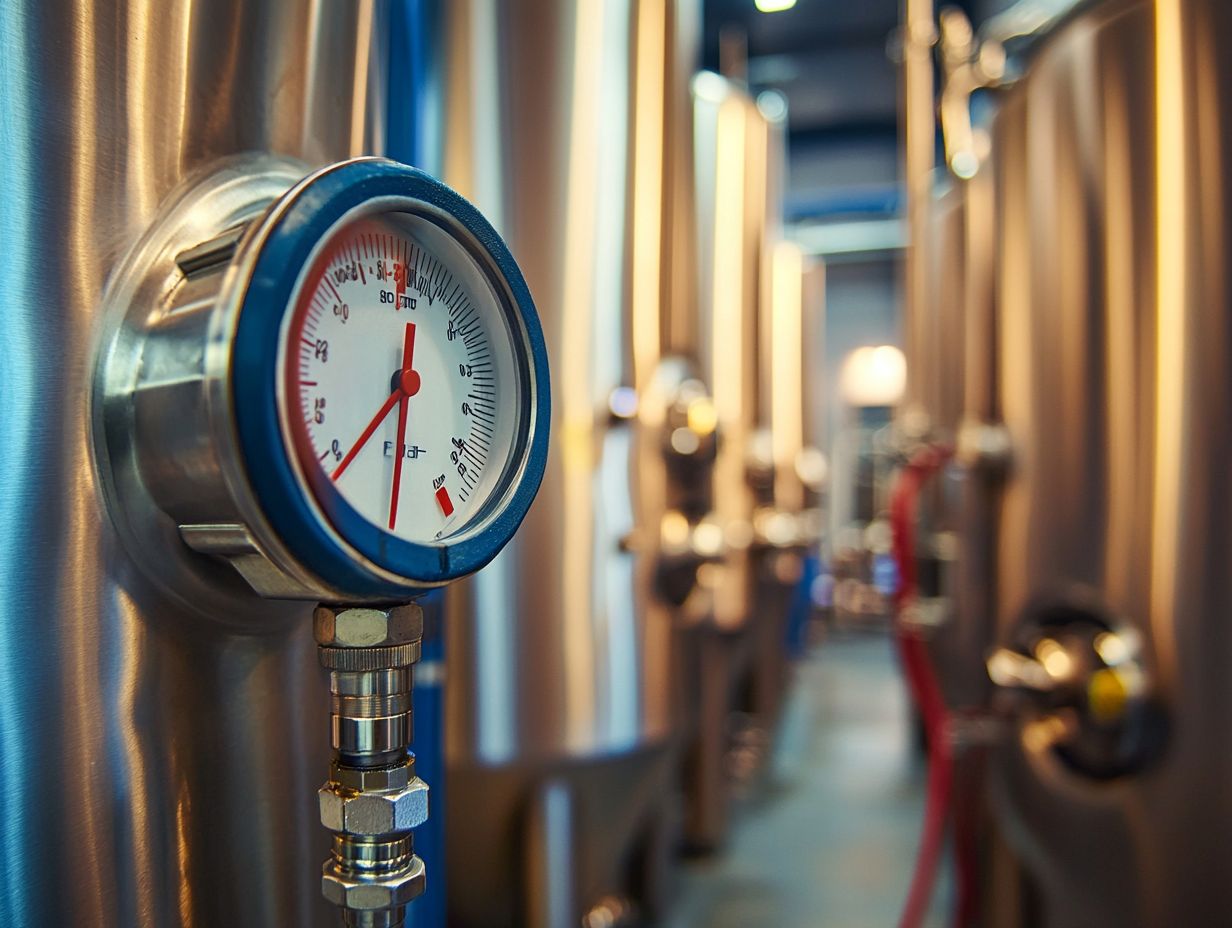
Take charge of your fermentation process with these effective management practices! Preventing low temperature issues during fermentation is crucial for safeguarding yeast health and achieving successful fermentation.
It’s essential to maintain optimal brewing conditions. This includes properly insulating fermentation vessels and diligently monitoring ambient temperatures. Effective temperature control is key to avoiding fermentation problems.
By pitching healthy yeast strains and adjusting your fermentation schedule based on temperature forecasts, you can significantly reduce the risks associated with low fermentation temperatures. Maintaining proper fermentation temperature ranges is crucial for fermentation performance.
To further elevate your fermentation outcomes, consider implementing temperature control systems like glycol chillers, which are systems that use a coolant to regulate temperatures precisely. These systems cool and heat precisely, keeping your yeast at its ideal temperature.
Regularly testing the wort temperature with calibrated thermometers enables you to make informed adjustments in a timely manner. This approach aligns with best fermentation practices.
Utilizing temperature-holding techniques, such as wrapping fermentation vessels in heat blankets or placing them in temperature-stable environments, will help you achieve a more consistent fermentation process. These strategies not only bolster yeast health but also lead to a more reliable and flavorful end product, ultimately enhancing your brewing performance.
Successful implementation of these techniques can prevent stuck fermentation.
What Are the Common Mistakes in Controlling Fermentation Temperature?
Controlling fermentation temperature is an intricate art, and overlooking key details can result in fermentation issues that compromise the quality of your beer. Frequent missteps include inadequate monitoring of fermentation temperatures, poor insulation of fermentation vessels, and failing to account for the specific yeast strain’s optimal temperature range.
Properly understanding fermentation temperature control is crucial. By recognizing these common pitfalls, you can refine your fermentation management practices and elevate the results of your brewing endeavors.
Addressing these issues will enhance your overall brewing process.
What Are the Factors That Can Affect Fermentation Temperature?
Several factors can influence fermentation temperature, significantly impacting both yeast health and the overall brewing process. These factors encompass ambient temperature, the insulation of fermentation vessels, the activity level of yeast strains, and the scale of your brewing operation.
By grasping these elements, you can effectively control fermentation conditions, ensuring an ideal environment for yeast activity and achieving fermentation success. Fermentation analysis will help in understanding these factors better.
The ambient temperature in your brewery may fluctuate due to seasonal changes, equipment operation, and other environmental conditions, all of which critically affect yeast metabolism.
Proper insulation of fermentation vessels is essential. It helps maintain consistent internal temperatures and minimizes the risk of extreme temperature swings that could stress the yeast.
Different yeast strains have their own optimal temperature ranges, which can ultimately dictate the flavor profile and fermentation speed of your brew. Understanding brewing science and fermentation principles will greatly aid in managing these fluctuations.
In larger operations, the increased yeast activity can produce more heat. It is crucial to implement effective cooling solutions. By actively monitoring and adjusting these factors, you can create an optimal fermentation environment that not only supports yeast health but also enhances the overall quality of your final product.
Effectively managing fermentation dynamics is key to achieving this. Start implementing these techniques today to see a remarkable difference in your brewing!
How to Monitor and Maintain the Right Fermentation Temperature?
Effectively monitoring and maintaining the ideal fermentation temperature is essential for achieving fermentation success and producing high-quality beer. You can harness advanced fermentation monitoring tools, including digital thermometers and temperature control systems, to keep an eye on temperature fluctuations and make timely adjustments. Proper management of the fermentation process is vital in this process.
By implementing consistent monitoring practices, you not only optimize yeast activity but also elevate the entire brewing process and enhance the characteristics of the final product. Utilizing fermentation monitoring tools and incorporating fermentation data are essential for this.
What Are the Best Tools for Monitoring Fermentation Temperature?
Utilizing the finest tools for monitoring fermentation temperature is crucial for effective fermentation management and elevating your brewing techniques. Advanced digital thermometers, temperature loggers, and automated fermentation control systems enable you to track temperatures with precision and consistency. These tools are essential for managing fermentation behavior and fermentation performance.
With these tools at your disposal, you can swiftly identify any deviations and implement corrective measures, ensuring that yeast activity remains within its optimal range throughout the entire fermentation process. Proper use of these tools supports effective brewing conditions.
By employing these tools, you can cultivate a more controlled brewing environment, significantly minimizing the risk of off-flavors and stalled fermentation that could jeopardize your final product. Digital thermometers offer real-time readings, enabling you to make quick adjustments, while temperature loggers meticulously record data over time, providing valuable insights into trends and fluctuations. This approach aligns with the principles of fermentation science.
Automated fermentation control systems enhance your brewing experience by automatically regulating temperature based on your programmed parameters. Embracing such technology not only streamlines your brewing process but also enhances consistency, resulting in higher-quality batches and an overall boost in brewing efficiency. This is particularly beneficial for maintaining the desired fermentation temperature and achieving optimum fermentation results.
What Are the Best Practices for Maintaining Fermentation Temperature?
Implementing best practices for maintaining fermentation temperature is crucial for ensuring the health of your yeast and achieving the brewing outcomes you desire. Regularly monitoring fermentation temperatures, using proper insulation techniques for your fermentation vessels, and adjusting environmental conditions as needed to prevent temperature fluctuations are all recommended practices for effective fermentation management.
By consistently keeping the fermentation temperature within the optimal range, you not only promote the desired flavor profiles but also reduce the risk of unwanted off-flavors. Consider utilizing temperature-controlled fermentation systems and incorporating digital thermometers for precise readings. Techniques such as submerged fermentation or making adjustments to the ambient room temperature can prove to be highly effective in maintaining yeast health.
Understanding both the upper and lower temperature limits is essential; even slight deviations can impact yeast activity and overall brew quality. By adhering to these actionable insights, you will ultimately ensure a more controlled fermentation process, resulting in improved consistency and flavor in every batch you create. Using fermentation monitoring tools helps track the fermentation data, ensuring your fermentation performance aligns with your brewing goals.
Frequently Asked Questions
In conclusion, monitoring and maintaining the right fermentation temperature is key to brewing success. By utilizing the best tools and practices, you can ensure a controlled fermentation process, resulting in exceptional beer quality. Start implementing these tips today and elevate your brewing experience!
What are some common signs of fermentation temperature issues?
Common signs include slow or stuck fermentation, off-flavors in the final product, and unusual yeast activity, such as excessive foaming or clumping.
How can I accurately measure the temperature of my fermentation process?
Use a thermometer placed directly in the fermenting liquid for the best accuracy. A stick-on thermometer on the outside of the vessel may be useful but is less precise. For comprehensive fermentation analysis, consider using advanced monitoring systems that provide real-time data.
What are some potential causes of temperature fluctuations during fermentation?
Temperature fluctuations can arise from ambient temperature changes, insufficient insulation or control in the fermentation vessel, or poor placement near heat sources or drafty areas. Understanding these dynamics and managing yeast properly can help mitigate issues.
How can I fix temperature issues during fermentation?
First, identify the source of temperature fluctuations and address it. This could involve insulating the fermentation vessel, relocating it to a stable environment, or using a temperature control device. Also, consider adjusting the room temperature or trying a yeast strain that tolerates a wider temperature range.
Can I still salvage my beer if it has been affected by temperature issues during fermentation?
Absolutely, you can often salvage your beer! You might need to let it sit longer to allow the yeast to continue fermenting and clean up off-flavors. Additional techniques like cold crashing (rapidly cooling the beer to clarify it) or fining can help improve the final product. However, if the temperature fluctuated too drastically or for extended periods, the beer may be beyond saving.
Are there any steps I can take to prevent fermentation temperature issues in the future?
Yes, there are several proactive steps you can take to prevent these issues:
- Use a temperature-controlled fermentation vessel.
- Insulate the vessel.
- Choose a yeast strain that tolerates a wider temperature range.
- Monitor the temperature regularly during fermentation.
Implementing good yeast propagation practices and understanding fermentation science can also lead to better brewing conditions.

